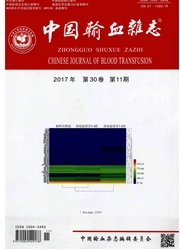

 中文摘要:
中文摘要:
目的探讨献血者血液筛查中实施核酸(NAT)检测后去掉1遍HBsAgELISA检测后HBsAg漏检的风险性,评估“1遍HBsAgELISA加1遍NAT”是否优于“2遍HBsAgELISA”的筛查策略。方法从本中心常规HBsAgELISA双试剂(国产新创试剂和进口BIOMERIEUX试剂)2遍筛查中任一试剂筛查不合格的献血者血样申随机留取616份。作NAT检测、补充血清学乙肝两对半检测及HBsAg确证试验,对ELISA单试剂不合格、NAT阴性但HB·sAg确证阳性标本追踪并重复上述检测加以进一步确认,分析去掉1遍HBsAgELISA检测后HBsAg漏检的风险性。结果616份ELISA双试剂筛查不合格标本中,有31份为新创试剂筛查合格NAT阴性但HBsAg中和试验确证阳性,因此如果去掉B10MERIEUxELISA试剂,采用新创ELISA试剂和NAT,那么原有2遍ELISA筛查不合格血液中将有5.0%(31/616)的HBsAg确证阳性血液会被漏检,按同期献血人群HBsAg不合格率0.32%推算,献血人群中将有16/10万HBsAg确证阳性的血液被漏检;有3份为BIOMERIEUX试剂筛查合格NAT阴性但HBsAg中和试验确证阳性,因此如果去掉新创ELISA试剂,采用BIOMERIEUXELISA试剂和NAT,那么原有2遍ELISA筛查不合格血液中将有0.5%(3/616)的HBsAg确证阳性血液会被漏检,同理推算献血人群中将有1.6/10万HBsAg确证阳性的血液被漏检。鉴于加做单人份NAT检测可从原“2遍ELISA筛查”合格血中检出121/10万的HBVDNA阳性血液,因此“进口ELISA+NAT”或“国产ELISA+NAT”分别可比“2遍ELISA筛查”多检出119.4/10万及105/10万HBV。结论就献血者血液HBV筛查而言,“1遍ELISA1遍NAT”的筛查策略比原有“2遍ELISA”筛查策略更能保障血液的安全性;以保留灵敏度和特异性较高的HBsAgELISA试剂更优。
 英文摘要:
英文摘要:
Objective To study the possible risk of deleting one of the two rounds of HBsAg ELISA screening after the nucleic acid testing (NAT) was implemented in donor screening and to evaluate whether the screening strategy of "one ELISA and one NAT" is better: than the strategy of "two rounds of ELISA". Methods 616 unqualified blood samples,which were screened by two rounds of ELISA with two different HBsAg ELISA kits (xinchuang and BIOMERIEUX), were col- lected. Samples were further tested by NAT, five HBV comple- mentally serological tests and HBsAg Confirmatory test. Donors with one kind of ELISA + and NAT- but confirmed HBsAg posi- tive were followed and followed samples were tested for the same tests. The false negative risk by deleting one ELISA Kit was ana-lyzed. Results Among 616 unqualified samples,31 were Xinchuang ELISA- NAT- but HBsAg Confirmatory test +. There- fore,if specimens were screened by Xinchuang ELISA reagent and NAT,5% (31/616) confirmed HBsAg + samples of the original two round ELISA unqualified samples would not be detected. Thus, 16 confirmed HBsAg + cases per 100000 donors would be missed,which was estimated based on the average 0.32% HBsAg positive rate in donors. On the other hand, three were BIOMERIEUX ELISA- NAT- but HBsAg Confirmatory test +. Therefore, if specimens were screened by BI- OMERIEUX ELISA reagent and NAT,0.5% (3/616) confirmed HBsAg + samples of the original two round ELISA un- qualified samples would not be detected. Thus, 1.6 confirmed HBsAg + cases per 100000 donors would be missed, which was also estimated based on the average 0.32% HBsAg positive rate in donors. Considering the implementation of 1D NAT can detect additional 121 HBV DNA positive in per 100 000 donors with qualified results by two round ELISA ( published data) BIOMERIEUX ELISA + NAT" or "Xinchuang ELISA + NAT" could detect additional 119. 4 per 100 000 or 105 per 100 000 respectively than "two rounds of ELISA'. Conclusion As for HBV, the screening
 同期刊论文项目
同期刊论文项目
 同项目期刊论文
同项目期刊论文
 期刊信息
期刊信息
